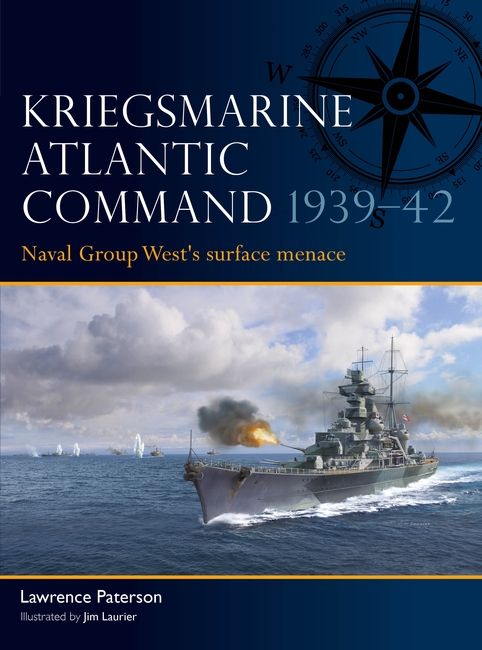
I have recently finished work on a new book for Osprey titled Kriegsmarine Atlantic Command 1939–42 detailing the surface threat posed by the German Navy within the Atlantic. It was, as always, a fascinating topic to research, going further than I have before into the mechanics of the major surface units and their commitment to battle. In my previous books the German capital ships have been peripheral to the primary topic, as I have focused on the U-boat war as well as delving into the world of S-boats, German security flotillas and the Luftwaffe maritime units. Furthermore, I have written about Wehrmacht units as diverse as the Luftwaffe’s armoured division and the Army’s Brandenburgers.
Perhaps surprisingly though, there is a consistent historical theme that runs through all of these works: the confusion of purpose that dogged the German military from its moment of rebirth under National Socialism.
The popular image of the German war machine that dominated Europe and swathes of Scandinavia, North Africa and the Soviet Union is of an implacable, fiercely determined and focused force equipped with cutting-edge weaponry. Nothing could be further from the reality. The Wehrmacht (and fledgling Waffen SS) of 1939 was woefully understrength, frequently equipped with weaponry more akin to the previous war than the next and – most devastating of all – lacking strategic focus.
For example, the Luftwaffe’s early development under the guidance of Generalleutnant Walther Wever had focussed on strategic bombing capability and close cooperation with the Navy. However, after his death in an aircraft accident in 1936, those who took over the reins changed tack and pursued a Luftwaffe suited primarily to direct cooperation with the Army; forgoing heavy bomber development for dive bombers and light to medium bombers. Perfect for the burgeoning concept of ‘Blitzkrieg’ but patently unsuited to the kind of continental warfare that would later involve area bombing of the United Kingdom and Soviet Union.
Likewise, the Kriegsmarine was built with a muddled purpose. After Hitler allayed fears among his senior military officers that war with Britain would not happen before 1944 at the earliest – if at all – senior naval planners pursued the concept of constructing an ambitiously large, balanced fleet capable to taking the war into blue water and slugging it out with opposing major naval forces. Not only was this type of fleet soon to become obsolete without significant integral aircraft units, but the construction plan put forward was far beyond Germany’s capabilities in manpower, raw materials and shipyard capacity. It also completely ignored the sole flicker of success that the Imperial German Navy had achieved in 1917: that of unrestricted U-boat warfare against the trans-Atlantic convoy routes on which Britain relied for survival. Indeed, Karl Dönitz’s U-boats remained the ‘poor relation’ of the Kriegsmarine until after war had broken out and never reached the numbers that he had deemed necessary for success until the end of 1942, by which time the U-boat war in the Atlantic had already failed.
The Kriegsmarine’s major surface units have passed into lore as fearsome Atlantic predators. Perhaps the most famous of these ships remains the Bismarck, one of the two ships of its namesake class, the largest built by the German Navy. This fearsome battleship has become etched into history with a reputation based primarily on the brutally surprising total destruction of HMS Hood in battle, and also on what could have been if the ship had been able to rampage unopposed through British convoy traffic The reality is far less impressive, as the very nature of the ship and its planned employment was another example of confused thinking, after its prospective role seesawed between naval juggernaut and mercantile raider while still under construction. Lacking focus on how the understrength Kriegsmarine was to wage war against the world’s oldest and most powerful European navy meant an ever-changing set of requirements. Thus, in reality, Bismarck was not well suited to its eventual role of Atlantic raider, though it never had an opportunity to prove or disprove this theory as it was hounded to exhaustion and sunk. The distinction of most successful Atlantic surface raider belongs to the less glamorous but far more suitable Panzerschiff, Admiral Scheer.

The Panzerschiff Admiral Scheer in Spain before World War II. (Author Collection)
I have become firmly convinced that Germany’s war was hamstrung internally by a combination of competing demands between services for a finite amount of manpower and raw materials, petty rivalries amongst senior military and political leaders and a reactive method of waging war, rather than one with a set of consistent strategic goals. As Hitler assumed more the mantle of command, his mercurial nature, often abetted by sycophantic officers attempting to curry favour for personal benefit, caused the Wehrmacht to ricochet from one theatre of action to another with little thought to logistical complications or the detriment to existing arenas of combat.
Therefore, I believe it is almost miraculous that the German military was able to achieve what it achieved on land, sea and in the air in operational areas that stretched from the frozen Arctic seas to the coast of New Zealand. Ultimately, the German war machine was of course defeated, but at a cost the like of which the world has never seen before. Hopefully, we will never see such a destructive toll ever again.
You can read more in Kriegsmarine Atlantic Command 1939–42: Naval Group West's surface menace

Comments
You must be logged in to comment on this post. Click here to log in.
Submit your comment